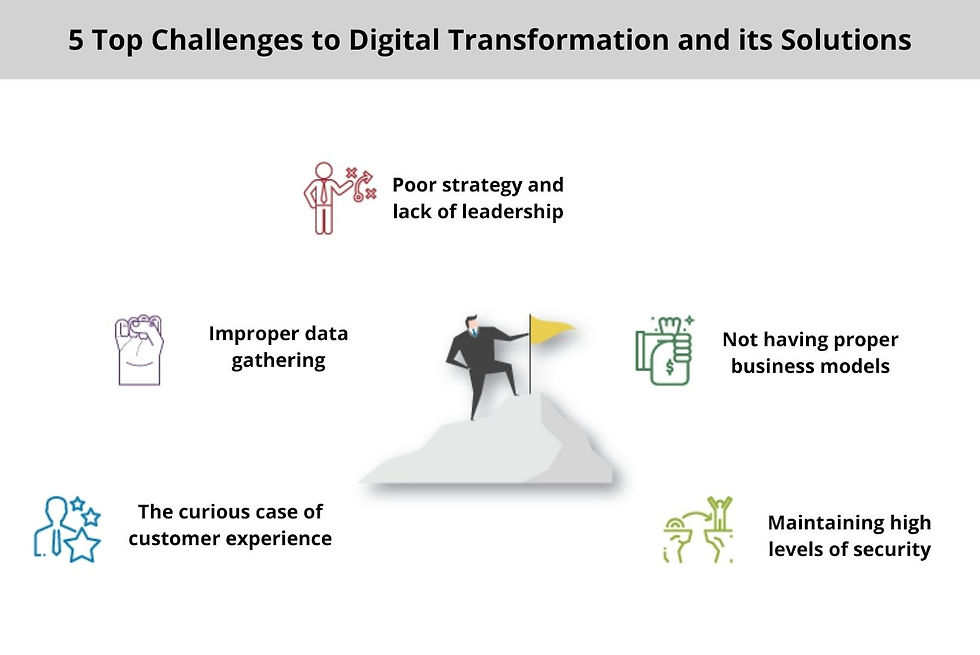Digital Transformation – What is it and its Best Practices?
- ClickInsights

- Mar 2, 2022
- 3 min read
By 2023, digitally transformed businesses are projected to contribute - accounting for $53.3 trillion - to more than half of the global GDP (IDC, 2020).
Customers nowadays demand simple and custom solutions to purchase things and services. These demands are putting businesses in a race against time as they attempt to keep up with rapid digital change. When organizations have clear objectives, a plan, and execution, the chance of achieving a successful sale triple.

Small businesses need to have a digital transformation strategy for a variety of reasons. It improves company culture, streamlines operations, increases output, and boosts performance. Adaptability is another advantage provided by following best practices for your digital transformation architecture. You may add and remove digital technologies as needed because you're following industry best practices.
A digital transformation strategy should be a long-term goal that includes strategies for using software to modify or upgrade existing workflows. You'll also have greater control over the data when you employ the correct digital transformation initiatives, allowing you to utilize it in beneficial ways to advance existing processes, and here are the best practices to do just that.
Define the Business Problem
Many technological advancements need to be implemented to improve customer experience and boost revenues. Digital transformation is a must for these goals because it utilizes numerous technologies and forms of implementation. Companies should keep in mind that technology is simply a tool for doing business; implementing it just because it's new may waste resources.

Digital transformation should be used to help the company achieve its objectives. Companies can establish clear goals and metrics for digitalization based on their understanding of the business issue, which aids in defining a clear strategy.
Prioritize Collaboration Between Team Members
Digital transformation can be a daunting task, but breaking it into smaller goals can make it more manageable. You'll want to ensure that all team members are on board with the digital transformation strategy and understand their role in achieving successful implementation. This includes individuals from various parts of the organization, such as marketing, IT, and operations.

A team effort is required for a company to function properly; therefore, it is built on people with various talents and specializations who collaborate toward a common goal. The synchronization of efforts in tasks like the digital transformation that need multidisciplinary work becomes even more essential. As such, on a single project, IT, management, and relevant departments must all work together.
Mind the Technology Legacy Cost
Digital transformation projects can be complex, and they should not be embarked on without a thorough understanding of the technology landscape. The goal is to identify the company's starting point and then build on it. Too often, companies try to adopt new technologies before they're ready, which can disrupt the entire business.

Technology is evolving at a rapid rate. As a result, certain technology applications will become outdated in less than a decade, leaving previously invested money stranded. To reduce the cost of technology legacy, businesses must thoroughly understand current trends and their potential impact on market dynamics. Following conferences on contemporary technology developments and enlisting the help of technology consulting firms can be a way forward.
Look Through the Perspective of Customers or User
When embarking on a digital transformation project, it's important to think through how customers or users will interact with the company. Too often, companies focus on the technology and not on the customer experience. A successful digital transformation considers all stakeholders' needs, not just those within the company.

Businesses must figure out what kind of services are in demand and what standards are required to improve the user experience. Setting up an easy and automated method for connecting with external consumers is a crucial instrument that may help them throughout or after the buying process - provide a personalized experience with content, offers, and/or support that's specific to each customer.
Conclusion
Digital transformation is a process that can help businesses improve their operations and become more efficient. However, it's not as simple as adopting new technology for the sake of being current.
When embarking on a digital transformation project, there are many factors to consider, such as the impact on customers and employees. By taking these things into account, businesses can develop a strategy that is best suited for their specific needs.


google 优化 seo技术+jingcheng-seo.com+秒收录;
Fortune Tiger Fortune Tiger;
Fortune Tiger Fortune Tiger;
Fortune Tiger Fortune Tiger;
Fortune Tiger Slots Fortune…
站群/ 站群
gamesimes gamesimes;
03topgame 03topgame
EPS Machine EPS Cutting…
EPS Machine EPS and…
EPP Machine EPP Shape…
Fortune Tiger Fortune Tiger;
EPS Machine EPS and…
betwin betwin;
777 777;
slots slots;
Fortune Tiger Fortune Tiger;